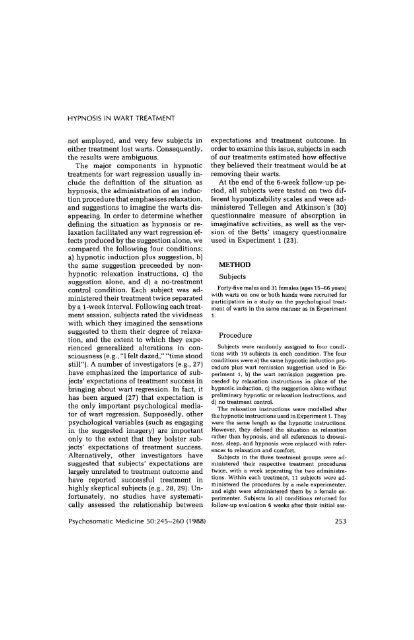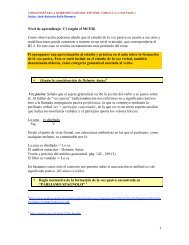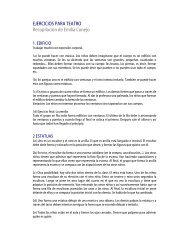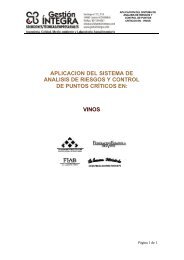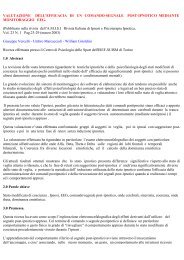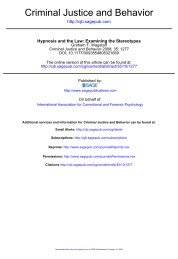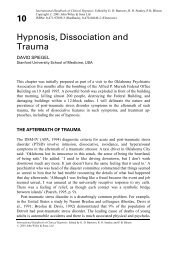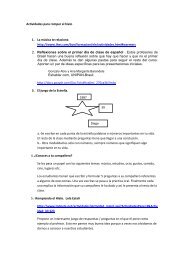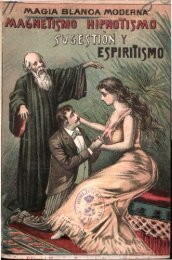Hypnosis, Placebo, and Suggestion in the Treatment of Warts
Hypnosis, Placebo, and Suggestion in the Treatment of Warts
Hypnosis, Placebo, and Suggestion in the Treatment of Warts
You also want an ePaper? Increase the reach of your titles
YUMPU automatically turns print PDFs into web optimized ePapers that Google loves.
HYPNOSIS IN WART TREATMENTnot employed, <strong>and</strong> very few subjects <strong>in</strong>ei<strong>the</strong>r treatment lost warts. Consequently,<strong>the</strong> results were ambiguous.The major components <strong>in</strong> hypnotictreatments for wart regression usually <strong>in</strong>clude<strong>the</strong> def<strong>in</strong>ition <strong>of</strong> <strong>the</strong> situation ashypnosis, <strong>the</strong> adm<strong>in</strong>istration <strong>of</strong> an <strong>in</strong>ductionprocedure that emphasises relaxation,<strong>and</strong> suggestions to imag<strong>in</strong>e <strong>the</strong> warts disappear<strong>in</strong>g.In order to determ<strong>in</strong>e whe<strong>the</strong>rdef<strong>in</strong><strong>in</strong>g <strong>the</strong> situation as hypnosis or relaxationfacilitated any wart regression effectsproduced by <strong>the</strong> suggestion alone, wecompared <strong>the</strong> follow<strong>in</strong>g four conditions;a) hypnotic <strong>in</strong>duction plus suggestion, b)<strong>the</strong> same suggestion preceeded by nonhypnoticrelaxation <strong>in</strong>structions, c) <strong>the</strong>suggestion alone, <strong>and</strong> d) a no-treatmentcontrol condition. Each subject was adm<strong>in</strong>istered<strong>the</strong>ir treatment twice separatedby a 1-week <strong>in</strong>terval. Follow<strong>in</strong>g each treatmentsession, subjects rated <strong>the</strong> vividnesswith which <strong>the</strong>y imag<strong>in</strong>ed <strong>the</strong> sensationssuggested to <strong>the</strong>m <strong>the</strong>ir degree <strong>of</strong> relaxation,<strong>and</strong> <strong>the</strong> extent to which <strong>the</strong>y experiencedgeneralized alterations <strong>in</strong> consciousness(e.g., "I felt dazed," "time stoodstill"). A number <strong>of</strong> <strong>in</strong>vestigators (e.g., 27)have emphasized <strong>the</strong> importance <strong>of</strong> subjects'expectations <strong>of</strong> treatment success <strong>in</strong>br<strong>in</strong>g<strong>in</strong>g about wart regression. In fact, ithas been argued (27) that expectation is<strong>the</strong> only important psychological mediator<strong>of</strong> wart regression. Supposedly, o<strong>the</strong>rpsychological variables (such as engag<strong>in</strong>g<strong>in</strong> <strong>the</strong> suggested imagery) are importantonly to <strong>the</strong> extent that <strong>the</strong>y bolster subjects'expectations <strong>of</strong> treatment success.Alternatively, o<strong>the</strong>r <strong>in</strong>vestigators havesuggested that subjects' expectations arelargely unrelated to treatment outcome <strong>and</strong>have reported successful treatment <strong>in</strong>highly skeptical subjects (e.g., 28, 29). Unfortunately,no studies have systematicallyassessed <strong>the</strong> relationship betweenexpectations <strong>and</strong> treatment outcome. Inorder to exam<strong>in</strong>e this issue, subjects <strong>in</strong> each<strong>of</strong> our treatments estimated how effective<strong>the</strong>y believed <strong>the</strong>ir treatment would be atremov<strong>in</strong>g <strong>the</strong>ir warts.At <strong>the</strong> end <strong>of</strong> <strong>the</strong> 6-week follow-up period,all subjects were tested on two differenthypnotizability scales <strong>and</strong> were adm<strong>in</strong>isteredTellegen <strong>and</strong> Atk<strong>in</strong>son's (30)questionnaire measure <strong>of</strong> absorption <strong>in</strong>imag<strong>in</strong>ative activities, as well as <strong>the</strong> version<strong>of</strong> <strong>the</strong> Betts' imagery questionnaireused <strong>in</strong> Experiment 1 (23).METHODSubjectsForty-five males <strong>and</strong> 31 females (ages 15-66 years)with warts on one or both h<strong>and</strong>s were recruited forparticipation <strong>in</strong> a study on <strong>the</strong> psychological treatment<strong>of</strong> warts <strong>in</strong> <strong>the</strong> same manner as <strong>in</strong> Experiment1.ProcedureSubjects were r<strong>and</strong>omly assigned to four conditionswith 19 subjects <strong>in</strong> each condition. The fourconditions were a) <strong>the</strong> same hypnotic <strong>in</strong>duction procedureplus wart remission suggestion used <strong>in</strong> Experiment1, b) <strong>the</strong> wart remission suggestion preceededby relaxation <strong>in</strong>structions <strong>in</strong> place <strong>of</strong> <strong>the</strong>hypnotic <strong>in</strong>duction, c) <strong>the</strong> suggestion alone withoutprelim<strong>in</strong>ary hypnotic or relaxation <strong>in</strong>structions, <strong>and</strong>d) no treatment control.The relaxation <strong>in</strong>structions were modelled after<strong>the</strong> hypnotic <strong>in</strong>structions used <strong>in</strong> Experiment 1. Theywere <strong>the</strong> same length as <strong>the</strong> hypnotic <strong>in</strong>structions.However, <strong>the</strong>y def<strong>in</strong>ed <strong>the</strong> situation as relaxationra<strong>the</strong>r than hypnosis, <strong>and</strong> all references to drows<strong>in</strong>ess,sleep, <strong>and</strong> hypnosis were replaced with referencesto relaxation <strong>and</strong> comfort.Subjects <strong>in</strong> <strong>the</strong> three treatment groups were adm<strong>in</strong>istered<strong>the</strong>ir respective treatment procedurestwice, with a week separat<strong>in</strong>g <strong>the</strong> two adm<strong>in</strong>istrations.With<strong>in</strong> each treatment, 11 subjects were adm<strong>in</strong>istered<strong>the</strong> procedures by a male experimenter,<strong>and</strong> eight were adm<strong>in</strong>istered <strong>the</strong>m by a female experimenter.Subjects <strong>in</strong> all conditions returned forfollow-up evaluation 6 weeks after <strong>the</strong>ir <strong>in</strong>itial ses-Psychosomatic Medic<strong>in</strong>e 50:245-260 (1988) 253


